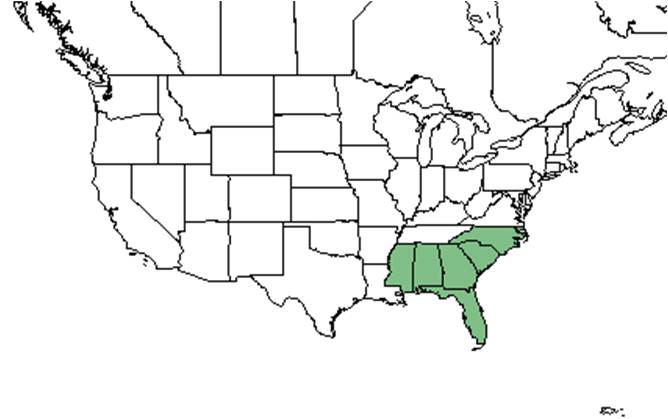Crocanthemum corymbosum
| Crocanthemum corymbosum | |
|---|---|

| |
| Photo by Jeff Norcini, Atlas of Florida Vascular Plants | |
| Scientific classification | |
| Kingdom: | Plantae |
| Division: | Magnoliophyta - Flowering plants |
| Class: | Magnoliopsida - Dicotyledons |
| Order: | Violales |
| Family: | Cistaceae |
| Genus: | Crocanthemum |
| Species: | C. corymbosum |
| Binomial name | |
| Crocanthemum corymbosum Michx. | |

| |
| Natural range of Crocanthemum corymbosum from USDA NRCS Plants Database. | |
Common name: pine barren frostweed
Synonym: Helianthemum corymbosum
Contents
Taxonomic notes
Description
C. corymbosum is a perennial species with alternate, simple leaves[1]. It has tomentose stems[2].
Generally, for the Crocanthemum genus, they are erect, heraceous or suffrutescent perennials with alternate, stellate-pubescent leaves. There are two types of flowers, chasmogamous and cleistogamous. Chasmogamous flowers are on the pedicels that elongate to usually more than 1 cm long with large showy, tallow petals; there are numerous stamens and large sepals. The cleistogamous flowers are on the pedicels are usually less than 3 mm long, where the petals are absent, the stamens are few and the sepals are smaller than those of the chasmogamous flowers. The sepals are in 2 whorls, the outer are narrower than the inner. The capsule is 3-locular (Radford 1964).
Specifically, for Crocanthemum corymbosum species, the roots have tuberous thickenings, the stems grow 1.3-5 tall, stellate canescent. The basal leaves are absent; the stem leaves 10-20, elliptic to oblanceolate, growing 1.5-3 cm long, and 5-10 mm wide, stellate-canescent above, tomentose beneath. The petioles 1-3 mm long. The cleistogamous flowers in compact terminal cymes; pedicels usually less than 5 mm long; the sepals and capsules 3-4 mm long. The chasmogamous flowers on pedicels 1-2 cm, scattered in the compact, the cleistogamous infloresence, or arising from its base; petals ca. 1 cm long; sepals and ovoid capsule, 5-7 mm long, pilose. The seeds are reddish brown in color, 1-1.2 mm long (Radford 1964).
Ecology
Habitat
It can been found in upland, well-drained sandy habitats, such as scrubby flatwoods (Pearson 1954)[3]. It has been observed growing in drying sand (FSU Herbarium). Associated species include Quercus virginiana, Q. myrtifolia, Q. pumila, Q. chapmanii, Serenoa repens, Osmanthus americanus, Vaccinium myrsinites, Aristida strica, and Trilisa odoratissima" (Pearson 1954).
Phenology
The canary yellow flowers bloom March through June [4].
Pollination
The following Hymenoptera families and species were observed visiting flowers of Crocanthemum corymbosum at Archbold Biological Station (Deyrup 2015):
Halictidae: Lasioglossum nymphalis
Photo Gallery
References and notes
Deyrup, M.A. and N.D. 2015. Database of observations of Hymenoptera visitations to flowers of plants on Archbold Biological Station, Florida, USA.
Florida State University Robert K. Godfrey Herbarium database. URL: http://herbarium.bio.fsu.edu. Last accessed: October 2015. Collectors: Loran C. Anderson. States and Counties: Florida: Franklin. Compiled by Tall Timbers Research Station and Land Conservancy.
Pearson, Paul G.. “Mammals of Gulf Hammock, Levy County, Florida”. American Midland Naturalist 51.2 (1954): 468–480.
Radford, Albert E., Harry E. Ahles, and C. Ritchie Bell. Manual of the Vascular Flora of the Carolinas. 1964, 1968. The University of North Carolina Press. 718-9. Print.